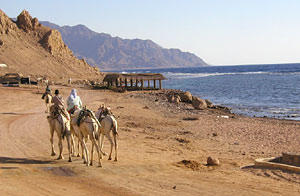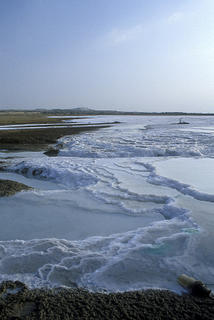Thoughts on Four Seas
There is so much history in the Bible, but we have to reflect on its geography also. Not just the history of Israel, but the geography of the Promised Land. The setting. On one side, the Great Sea, the Mediterranean. The Philistines came through [or rather, over] the Great Sea from Crete. They lived in Canaan, alongside the Israelites. But the land was not theirs. They lived in the land as encroachers, or squatters; they had no legal title over the land. They came through the sea – but it was not the sea that God had in mind. God calls them the ‘uncircumcised Philistines’. They are living in the land, but they are not ‘true’, not ‘genuine’ – they lack the real experience.
So what is the real experience? They came over the Mediterranean Sea in their great ships, but they never came ‘through the Red Sea’.

Have you not wondered why the Red Sea experience is mentioned in the Bible again and again? The Lord is my strength and my song, and He has become my salvation. The Israelites sang the song of praise and worship after they came through the Red Sea. They went through the experience of baptism and they spontaneously sang the glorious song recorded in Exodus 15 – a fragment of which is repeated several times in the Old Testament – and which is mentioned finally in the last book, Revelation.
Now on the other side of Palestine we have two more seas – inland seas. One is a fresh sea, a living sea – and the other is a Dead Sea. The fresh-water sea is called the Sea of Galilee or the Sea of Tiberias or the Sea of Gennasaret [Chennerith]. Jesus crossed that sea several times in a boat with His disciples. He stilled that sea when a tempest raged in it. He walked over its stormy waves. Jesus is closely associated with that Sea.

The Sea of Galilee is formed by the waters of the river Jordan as they flow down from Mount Hermon. It is a fresh-water sea, full of fish. We remember how Peter one mid-morning [Luke 5] caught a huge haul of fish, so much so that his boat started sinking. We remember how in John 21 how the seven disciples caught 153 large fish – and although there were so many, the net was not broken. The Sea of Galilee is famous both for its fish and for its storms.
The Sea of Galilee receives fresh water from the mountains and sends that water downstream through the River Jordan. It receives and it gives. The water flows through it. There is a continual supply downstream into the valley of the Jordan.
But there is another Sea, the Dead Sea.

There are no fish in it. It is a heavy and stagnant sea. It receives water, but does not send the water downstream. It is a Dead Sea. You can float in that sea. Long ago, by the shores of the Dead Sea, there was a green and flourishing valley ‘like the land of Egypt as you go to Zoar’, Gen 13.10. There were many prosperous cities near that sea, such as Sodom and Gomorrah. Today, the region around the Dead Sea is a desert and bears the scars of divine judgment.
I believe that God is speaking through the geography of these three Seas – the Sea of Galilee, the Dead Sea and the Red Sea. We can be like the Sea of Galilee – fresh and living and giving – or we can be like the Dead Sea [always receiving, not giving]. But the important thing is that we all need to go ‘through the Red Sea’. It is that baptism [1 Cor 10.2] that is important if we want to have a living faith in the Lord Jesus [Psalm 106.12, Exod 14.31b] and allow the streams of living water to flow from us. Not just one experience, but several such experiences of the Red Sea – if we must know the power of the living God and the reality of [death-burial-and-] resurrection.
So what is the real experience? They came over the Mediterranean Sea in their great ships, but they never came ‘through the Red Sea’.

Have you not wondered why the Red Sea experience is mentioned in the Bible again and again? The Lord is my strength and my song, and He has become my salvation. The Israelites sang the song of praise and worship after they came through the Red Sea. They went through the experience of baptism and they spontaneously sang the glorious song recorded in Exodus 15 – a fragment of which is repeated several times in the Old Testament – and which is mentioned finally in the last book, Revelation.
Now on the other side of Palestine we have two more seas – inland seas. One is a fresh sea, a living sea – and the other is a Dead Sea. The fresh-water sea is called the Sea of Galilee or the Sea of Tiberias or the Sea of Gennasaret [Chennerith]. Jesus crossed that sea several times in a boat with His disciples. He stilled that sea when a tempest raged in it. He walked over its stormy waves. Jesus is closely associated with that Sea.

The Sea of Galilee is formed by the waters of the river Jordan as they flow down from Mount Hermon. It is a fresh-water sea, full of fish. We remember how Peter one mid-morning [Luke 5] caught a huge haul of fish, so much so that his boat started sinking. We remember how in John 21 how the seven disciples caught 153 large fish – and although there were so many, the net was not broken. The Sea of Galilee is famous both for its fish and for its storms.
The Sea of Galilee receives fresh water from the mountains and sends that water downstream through the River Jordan. It receives and it gives. The water flows through it. There is a continual supply downstream into the valley of the Jordan.
But there is another Sea, the Dead Sea.

There are no fish in it. It is a heavy and stagnant sea. It receives water, but does not send the water downstream. It is a Dead Sea. You can float in that sea. Long ago, by the shores of the Dead Sea, there was a green and flourishing valley ‘like the land of Egypt as you go to Zoar’, Gen 13.10. There were many prosperous cities near that sea, such as Sodom and Gomorrah. Today, the region around the Dead Sea is a desert and bears the scars of divine judgment.
I believe that God is speaking through the geography of these three Seas – the Sea of Galilee, the Dead Sea and the Red Sea. We can be like the Sea of Galilee – fresh and living and giving – or we can be like the Dead Sea [always receiving, not giving]. But the important thing is that we all need to go ‘through the Red Sea’. It is that baptism [1 Cor 10.2] that is important if we want to have a living faith in the Lord Jesus [Psalm 106.12, Exod 14.31b] and allow the streams of living water to flow from us. Not just one experience, but several such experiences of the Red Sea – if we must know the power of the living God and the reality of [death-burial-and-] resurrection.

1 Comments:
Thank you for a neat blog. I invite you to visit my blog and to study baptism and the Holy Spirit with me.
http://baptism-holyspirit.blogspot.com/
Terry Finley
happy.finley@gmail.com
Post a Comment
<< Home